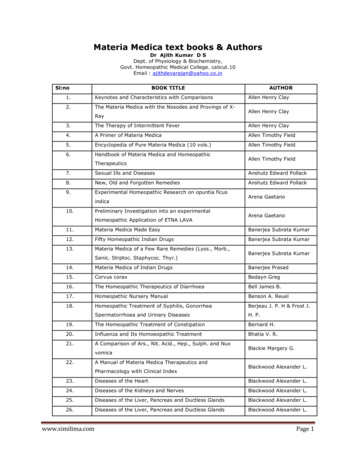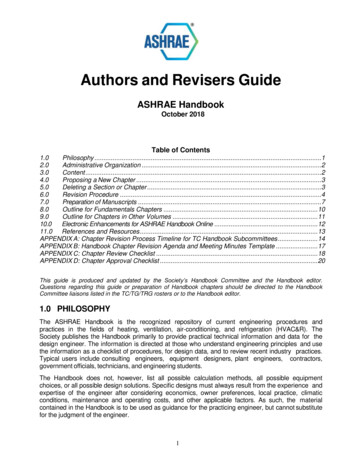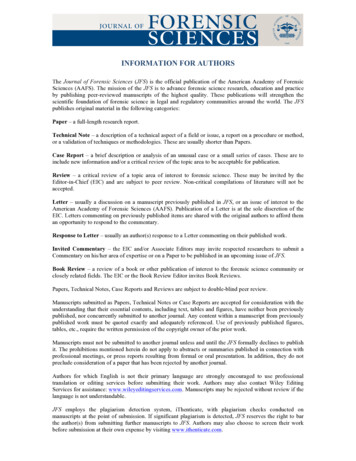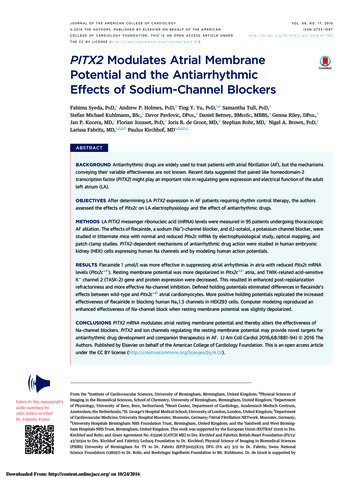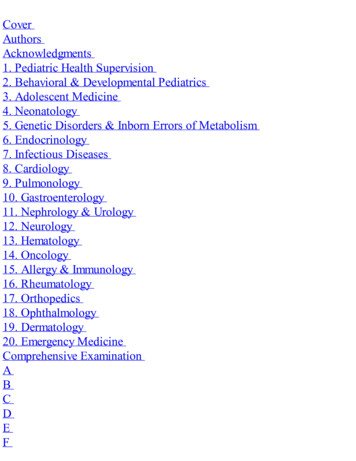
Transcription
CoverAuthorsAcknowledgments1. Pediatric Health Supervision2. Behavioral & Developmental Pediatrics3. Adolescent Medicine4. Neonatology5. Genetic Disorders & Inborn Errors of Metabolism6. Endocrinology7. Infectious Diseases8. Cardiology9. Pulmonology10. Gastroenterology11. Nephrology & Urology12. Neurology13. Hematology14. Oncology15. Allergy & Immunology16. Rheumatology17. Orthopedics18. Ophthalmology19. Dermatology20. Emergency MedicineComprehensive ExaminationABCDEF
GHIJKLMNOPQRSTUVWXYZ
AuthorsLloyd J. Brown MD, FAAPAssociate DirectorPediatric Residency Training Program, Cedars-Sinai Medical Center, Course Chair,Pediatric Clerkship; Associate Professor of Pediatrics, David Geffen School of Medicineat UCLALee Todd Miller MD, FAAPDirectorPediatric Residency Training Program, Cedars-Sinai Medical Center; Professor ofPediatrics, David Geffen School of Medicine at UCLAContributorsLloyd J. Brown MD, FAAPAssociate DirectorPediatric Residency Training Program, Cedars-Sinai Medical Center, Los Angeles,California, Course Chair, Pediatric Clerkship; Associate Professor of Pediatrics, DavidGeffen School of Medicine at UCLA, Los Angeles, CaliforniaLee Todd Miller MD, FAAPDirectorPediatric Residency Training Program, Cedars-Sinai Medical Center, Los Angeles,California; Professor of Pediatrics, David Geffen School of Medicine at UCLA, LosAngeles, CaliforniaTiffany Merrill Becker MDDivision of Academic Primary Care Pediatrics, Cedars-Sinai Medical Center, Los Angeles,CaliforniaPeter A. Blasco MD, FAAPDirectorNeurodevelopmental Program, Child Development and Rehabilitation Center, Portland,Oregon; Associate Professor of Pediatrics, Oregon Health and Science University,Portland, OregonDavid Seung Chun MDFellowPediatric Cardiology, James Whitcomb Riley Hospital for Children, Indiana UniversitySchool of Medicine, Indianapolis, Indiana
David A. Ferry MD, FAAP, FACCDirectorPediatric Cardiology, Cedars-Sinai Medical Center, Los Angeles, California; ClinicalAssociate Professor of Pediatrics, David Geffen School of Medicine at UCLA, Los Angeles,CaliforniaCarole Hurvitz MD, FAAPDirectorPediatric Hematology-Oncology, Cedars-Sinai Medical Center, Los Angeles, California;Professor of Pediatrics, David Geffen School of Medicine at UCLA, Los Angeles,CaliforniaElaine S. Kamil MDClinical DirectorPediatric Nephrology; Program Director, Pediatric Nephrology Fellowship Program,Cedars-Sinai Medical Center, Los Angeles, California; Professor of Pediatrics, DavidGeffen School of Medicine at UCLA, Los Angeles, CaliforniaDeborah Lehman MD, FAAPAssociate DirectorPediatric Infectious Diseases, Cedars-Sinai Medical Center, Los Angeles, California;Assistant Professor of Pediatrics, David Geffen School of Medicine at UCLA, Los Angeles,CaliforniaCalvin G. Lowe MD, FAAPMedical DirectorChildren's Emergency Transport, Attending Physician, Division of Emergency andTransport Medicine, Childrens Hospital Los Angeles, Los Angeles, California; AssistantProfessor of Pediatrics, Keck School of Medicine at the University of SouthernCalifornia, Los Angeles, CaliforniaElizabeth Mumper MD, FAAPPresident and CEOAdvocates for Children, Lynchburg, Virginia; Associate Professor of Clinical Pediatrics,University of Virginia School of Medicine, Charlottesville, VirginiaRonald A. Nagel MD, FAAPClinical Assistant Professor of PediatricsDavid Geffen School of Medicine at UCLA, Los Angeles, CaliforniaCharles E. Niesen MD, FRCPC
Division of Pediatric NeurologyCedars-Sinai Medical Center, Los Angeles, California; Assistant Professor of Pediatricsand Neurology, David Geffen School of Medicine at UCLA, Los Angeles, CaliforniaKathy L. Perkins MD, PhD, FAAPVice ChairPediatric Clinical Services, Cedars-Sinai Medical Center, Los Angeles, California;Associate Professor of Pediatrics, David Geffen School of Medicine at UCLA, Los Angeles,CaliforniaRobert K. Rhee MDPediatric OphthalmologistDepartments of Pediatrics and Surgery; Associate Professor of Ophthalmology, MedicalCollege of Ohio, Toledo, OhioMarta R. Rogido MD, FAAPDivision of Neonatal-Perinatal Medicine; Assistant Professor of Pediatrics, EmoryUniversity School of Medicine, Atlanta, GeorgiaAnnette B. Salinger MD, FAAPPalo Alto Medical Foundation, Palo Alto, California, Clinical Instructor, StanfordUniversity School of Medicine, Stanford, CaliforniaSrinath Sanda MDDivision of General Internal Medicine, Division of Academic Primary Care Pediatrics,Cedars-Sinai Medical Center, Los Angeles, CaliforniaMargaret Sanford MDAssociate Pediatric Hematologist-OncologistCedars-Sinai Medical Center, Los Angeles, California; Clinical Assistant Professor ofPediatrics, David Geffen School of Medicine at UCLA, Los Angeles, CaliforniaHarry W. Saperstein MDDirectorPediatric Dermatology, Cedars-Sinai Medical Center, Los Angeles, California; ClinicalAssociate Professor of Pediatrics and Medicine, David Geffen School of Medicine atUCLA, Los Angeles, CaliforniaFrank T. Saulsbury MDHeadDivision of Immunology and Rheumatology, Department of Pediatrics, University of
Virginia Health Systems, Charlottesville, Virginia; Professor of Pediatrics, University ofVirginia School of Medicine, Charlottesville, VirginiaNirali P. Singh MD, FAAPFellowPediatric Infectious Diseases, Cedars-Sinai Medical Center, Los Angeles, CaliforniaLiliana Sloninsky MDAssociate Pediatric Hematologist-OncologistCedars-Sinai Medical Center, Los Angeles, California; Clinical Assistant Professor ofPediatrics, David Geffen School of Medicine at UCLA, Los Angeles, CaliforniaAugusto Sola MD, FAAPDirectorNeonatal-Perinatal Medicine; Professor of Pediatrics and Obstetrics and Gynecology,Emory University School of Medicine, Atlanta, GeorgiaJerome K. Wang MD, FAAPAssociate DirectorInternal Medicine–Pediatrics Residency Training Program, Cedars-Sinai Medical Center,Los Angeles, California; Assistant Professor of Pediatrics, David Geffen School ofMedicine at UCLA, Los Angeles, CaliforniaFrederick D. Watanabe MD, FAAPPediatric Liver and Intestinal TransplantationChildrens Hospital Los Angeles, Los Angeles, California; Associate Professor ofPediatrics, David Geffen School of Medicine at UCLA, Los Angeles, CaliforniaLauren J. Witcoff MDDivision of Pediatric Pulmonary MedicineLucile Packard Children's Hospital, Palo Alto, California; Clinical Associate Professor ofPediatrics, Stanford University School of Medicine, Stanford, CaliforniaKenneth W. Wright MD, FAAPDirectorWright Foundation for Pediatric Ophthalmology; Director, Pediatric OphthalmologyResearch and Education, Cedars-Sinai Medical Center, Los Angeles, California; ClinicalProfessor of Ophthalmology, Keck School of Medicine at the University of SouthernCalifornia, Los Angeles, CaliforniaSharon L. Young MD
Associate Medical DirectorChildren's Health Clinic, Cedars-Sinai Medical Center, Los Angeles, California; AssistantProfessor of Pediatrics, David Geffen School of Medicine at UCLA, Los Angeles,CaliforniaSecondary EditorsNeil MarquardtEditorElena ColerManaging EditorKaren RuppertSenior Project EditorScott LavineMarketing ManagerRisa ClowDesignerPeirce Graphic ServicesCompositorDRCPrinter
AcknowledgmentsWe would both like to recognize individuals who have made tremendous impacts on ourmedical education and on our professional growth and development.I have been so privileged to learn from some outstanding teachers and mentors, both atUCLA and at Cedars-Sinai. Lee Miller, the coeditor of this book, is perhaps the mosteffective teacher I have known and has influenced my career immeasurably. I wouldnot have discovered my love for teaching without his mentorship and encouragement. Iam also grateful to friends and colleagues who are role model educators and clinicians,including Dr. Kate Perkins and Dr. Neal Kaufman.Lloyd J. BrownI will be forever grateful for the mentorship, teaching, encouragement, and friendshipof Mrs. Sylvia Civin of New York City and of Dr. Leigh Grossman, Dr. Dick Kesler, and Dr.Frank Saulsbury of the University of Virginia School of Medicine.Lee T. MillerWe would not have been able to undertake and complete this text without theprofessional encouragement, great mentorship, and wonderful support of Dr. DavidRimoin, our Chair of the Department of Pediatrics at Cedars-Sinai Medical Center, andProfessor of Pediatrics and Internal Medicine of the David Geffen School of Medicine atUCLA.We would also like to thank our colleagues within the Division of Academic PrimaryCare Pediatrics at Cedars-Sinai Medical Center for their great support, and for being thewonderful colleagues and dear friends that they are to both of us.We owe much gratitude as well to Lisa Payne and Lois Kuperman in the Department ofPediatrics at Cedars-Sinai Medical Center, whose technical support, friendship, hardwork, warm spirits, and endless cups of coffee were so tremendously appreciated.And lastly, we owe so much to our present and past pediatric and medicine-pediatrichousestaff with whom we feel very close, and to the hundreds of medical students fromall across the country, but most especially those from the David Geffen School ofMedicine at UCLA, who have stimulated us, energized us, and taught us so much alongthe way.Lloyd J. BrownLee T. Miller
1Pediatric Health SupervisionKathy L. Perkins M.D., Ph.D.I. Well Child Care—General ConceptsA. The purpose of routine well child careis to provide for the longitudinal health care needs of children from birth throughadolescence. Components of well child care include:1. Anticipatory guidance (e.g., diet, healthy lifestyle promotion)2. Specific preventive measures (e.g., immunizations)3. Screening tests to detect asymptomatic diseases (e.g., vision, hearing, newbornmetabolic screening, tuberculosis screening)4. Early detection and treatment of symptomatic acute illness to preventcomplications5. Prevention of disability in chronic disease6. Assessment of growth and developmentB. Content of the well child visit1. History provides an opportunity to obtain diagnostic information and to form adoctor–patient–family alliance. The interview is shaped by family and patientconcerns and by age-specific trigger questions about common problems (e.g., sleep,nutrition, behavior).2. Developmental surveillance is gathered through age-specific questioning,developmental questionnaires, observations during the visit, screening tests, andreview of academic school performance.3. Observation of parent–child interaction4. Physical examination should be comprehensive and also should focus on growth (i.e.,length/height, weight, head circumference, and body mass index).5. Additional screening tests depend on the age of the child and may include leadlevel, hemoglobin, and urinalysis screens and at 4 years of age, blood pressure and
hearing and vision assessment.6. Immunizations7. Anticipatory guidance includes a discussion of safety issues, and upcomingdevelopmental issues.II. GrowthA. Normal Growth1. Weight, height, head circumference (until 2 years of age), and sexual maturity areroutinely monitored during well child care to assess for adequacy of growth anddevelopment.2. Standardized growth curves represent normal values for age for 95% of children andare used to plot weight, height, body mass index, and head circumference. Specialgrowth curves exist for children with particular genetic conditions (e.g., Downsyndrome, achondroplasia).3. Tables 1-1, 1-2 and 1-3 detail general “rules of thumb” for expected gains in weight,height, and head circumference. Sexual maturity rating scales are found in Chapter3, Figures 3-1 and 3-3.B. Growth disturbancesare defined as growth outside of the usual pattern. Two common types of growthdisturbance include failure to thrive and head growth abnormalities.1. Failure to thrive (FTT)a. Definition. FTT is a term used to describe a growth rate of less than expected for achild, and is of particular concern when a child's weight crosses two majorpercentile isobars on National Health Statistics charts.b. FTT may involve all growth parameters although weight gain is generally the mostabnormal. This should be distinguished from isolated short stature, in which heightis the most abnormal growth parameter (see Chapter 6, section I).c. In children with FTT, weight is usually affected before length, which is usuallyaffected before head circumference (head circumference is initially spared in FTT).Table 1-1. Rules of Thumb for Expected Increase in Weight
AgeExpected Weight IncreaseBirth–3 months30 g/dayRegain birth weight by 2 weeks3–6 months20 g/dayDouble birth weight by 4–6 months6–12 months10 g/dayTriple birth weight by 12 months1–2 years250 g/month2 years–adolescence2.3 kg/year30 g 1 ounce body weight.Table 1-2. Rules of Thumb for Expected Increase in HeightAgeExpected Height Increase0–12 months25 cm/yearBirth length increases by 50% at 12 months13–24 months12.5 cm/year2 years–adolescence6.25 cm/yearBirth length doubles by age 4 yearsBirth length triples by age 13 yearsd. Etiologies of FTT are outlined in Figures 1-1 and 1-2, which include both inorganicor psychosocial causes and organic etiologies.
1. The most common cause of FTT is inorganic FTT (i.e., a disturbed parent–childbond that results in inadequate caloric intake or retention).2. Organic etiologies suggest underlying organ system pathology, infection,chromosomal disorders, or systemic illness.e. Evaluation of FTT requires a careful history and physical examination, a completedietary history, and observation of the parent–child interaction.1. Routine screening tests are usually not useful, and laboratory evaluationshould therefore be focused and directed by clues from the history and physicalexamination.2. Evaluation of potential organic etiologies will be directed by the timing or onsetof FTT, i.e., prenatal onset of inadequate weight gain (as in intrauterine growthretardation) should be distinguished from postnatal onset of inadequate weightgain.2. Head growth abnormalities include microcephaly, craniosynostosis, deformationa
Pediatrics at Cedars-Sinai Medical Center, whose technical support, friendship, hard work, warm spirits, and endless cups of coffee were so tremendously appreciated. And lastly, we owe so much to our present and past pediatric and medicine-pediatric housestaff with whom we feel very close, and to the hundreds of medical students from all across the country, but most especially those from the .

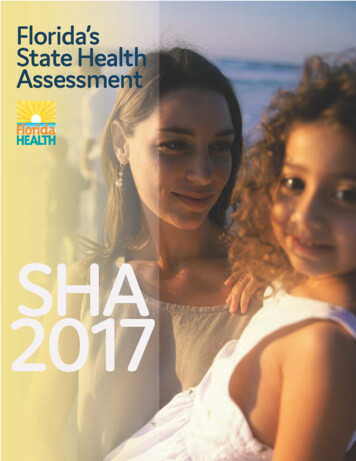



![[Page 1 – front cover] [Show cover CLEAN GET- AWAY 978-1 .](/img/13/9781984892973-6648.jpg)
